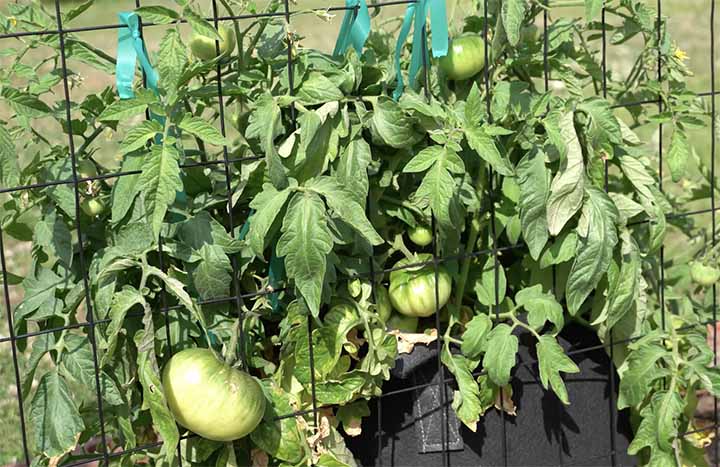If you want to plant a single tomato plant and harvest fruits throughout the summer, you want to look at indeterminate tomatoes. Fortunately, there are all sorts of indeterminate tomato varieties, including heirlooms, hybrids, slicers, and cherries.
Over the years, I’ve come to love many different indeterminate types. I always plant a few delicious and time-tested heirlooms as well as newer hybrids that stand up to disease pressure.
If you’re not sure what varieties of tomato to plant in your garden, check out some of the best indeterminate tomatoes.
What Are Indeterminate Tomatoes?
Growers classify tomatoes in many ways, including by their growth habit. Most tomatoes are either determinate or indeterminate, but there are a few semi-determinate types.
Indeterminate tomatoes continue growing until the plants die. I’ve personally seen indeterminate tomato vines that have grown over 30 feet long!
This large size means that these tomatoes benefit from staking, trellising, or another form of containment. Pruning can also help contain the plants, prevent disease, and encourage fruit production.
As the vines continue to grow, the plants also continue to produce flowers and fruit. This means indeterminate tomatoes produce their fruits over an extended period of time—often three or four months.
Indeterminate Vs. Determinant Tomatoes
As mentioned above, indeterminate tomatoes continue to grow indefinitely and also set fruit over an extended period of time.
Determinate tomatoes stop growing when they reach a certain height and also produce all their fruit in the period of a few weeks.
For comparing these 2 varieties in more detail, check out my article: Determinate vs Indeterminate Tomatoes.
Best Indeterminate Tomato Varieties
Many of my favorite types of tomatoes are indeterminate, and it’s hard to choose just a handful to grow each year! I typically end up growing some of my tried and true favorites as well as a few new varieties each year.
If you’re looking to get started growing tomatoes or are just looking for some new varieties to test out, start with this list of favorites.
1. Cherokee Purple
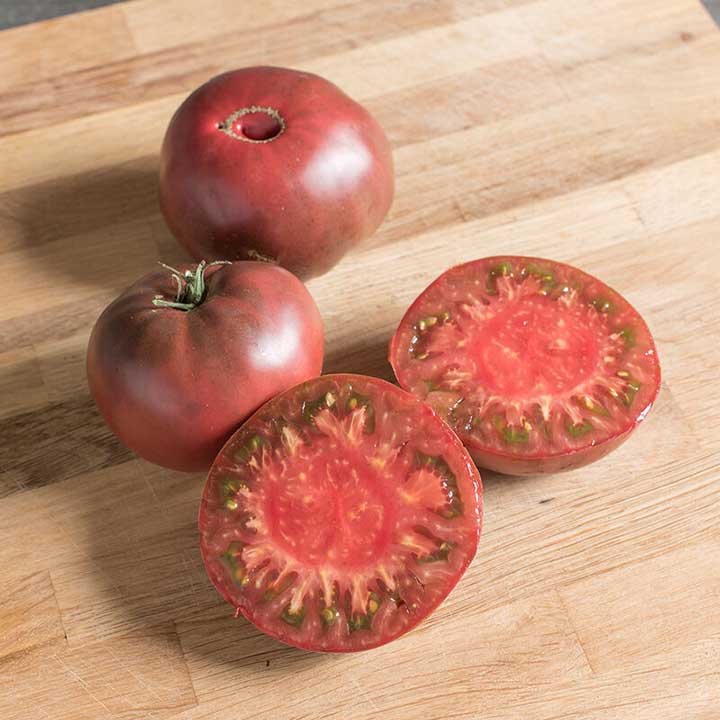
Type: heirloom slicer
If I had to pick one tomato to eat for the rest of my life, it would have to be the Cherokee Purple.
The fruit is large enough that one slice makes a satisfying tomato sandwich that drips with sweet tomato juices. As the name suggests, the fruits have a purple tinge with sweetness, acidity, and a hint of smokiness.
This heirloom variety has been around for hundreds of years, and many people think the variety was first grown by the Cherokee people. Once the plant was introduced to seed companies, it quickly became a hit and spread throughout the country.
While the fruits are delicious, they are also prone to cracking in heavy rains. Therefore, I like to pick fruits that have any bit of color on them if I know a storm is coming.
Pros
- Great tasting
- good texture
Cons
- Susceptible to numerous diseases
2. Brandywine

Type: heirloom slicer
The Brandywine is another time-tested favorite. This heirloom produces large slicing tomatoes that range in color from dark pink to red.
Each tomato can weigh over one pound, and fruits up to one and a half pounds are common. They have a rich flavor that is both acidic and sweet—many people describe this variety as the best-tasting tomato they’ve tried.
The plants take 78 days to produce fruits from transplant, so get these plants in the ground as early as possible.
Pros
- Delicious fruits
- Big fruits
Cons
- Not the best producer
3. Sungold

Type: hybrid cherry
If there’s one cherry tomato most people love, it’s the Sungold. These golden globes are super sweet and flavorful—one of my past customers told me “they’re better than candy!”
Not only are the tomatoes delicious, but the plants also produce an abundance of them.
Sungolds are prone to splitting—especially after a storm—which can make picking a bit of a chore. To avoid split fruit, you can pick the tomatoes when they are a bit underripe and allow them to fully ripen off the vine.
Pros
- Excellent flavor
- Prolific
Cons
- Fruits prone to splitting
4. Early Girl

Type: hybrid slicer
This variety continues to show up in plant nurseries and gardens for good reason. Like its name suggests, Early Girl is one of the first tomato varieties to produce fruit.
In just 60 days after transplant, it begins to produce which means you can be eating tomatoes in mid-June if you plant them out in Mid-April. Just remember to wait until the danger of frost has passed to transplant.
Early Girl also has great drought resistance, which can be helpful if you go out of town regularly or live in a dry area.
Read our article for how to grow Early Girl Tomatoes.
Pros
- Tolerant to drought and high heat
- Quick producers
Cons
- Susceptible to early and late blight
5. Pink Berkeley Tie Dye
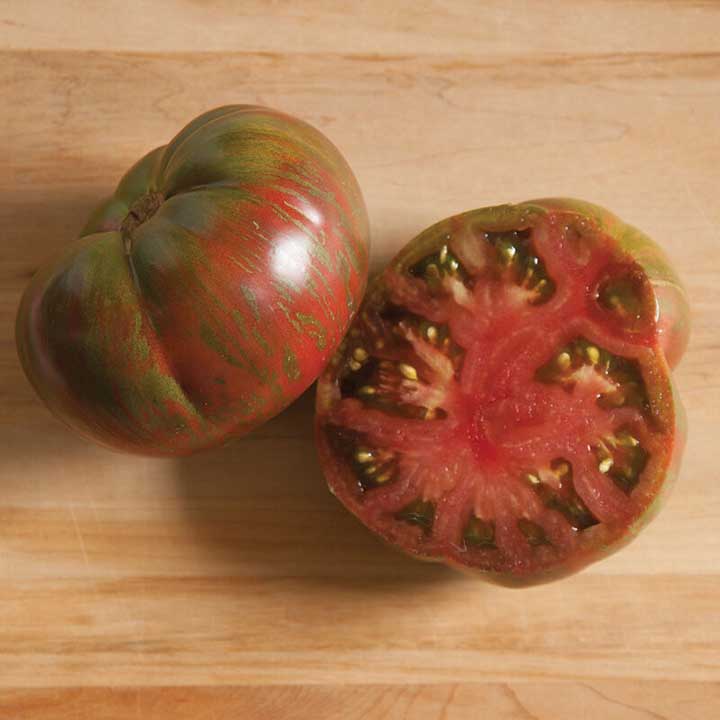
Type: heirloom slicer
The Pink Berkeley Tie Dye is another one of my favorite heirloom varieties. The fruits are medium in size, have stunning red and green stripes, and have an acidic, sweet, and bold flavor.
It takes about 70 days from transplant until the first fruit is ripe. As long as the plants remain disease free and well cared for, they will continue to produce tomatoes throughout the following few months.
You can read my article about growing this specific tomato variety here.
Pros
- Delicious flavor
Cons
- Not the biggest producer
6. Speckled Roman
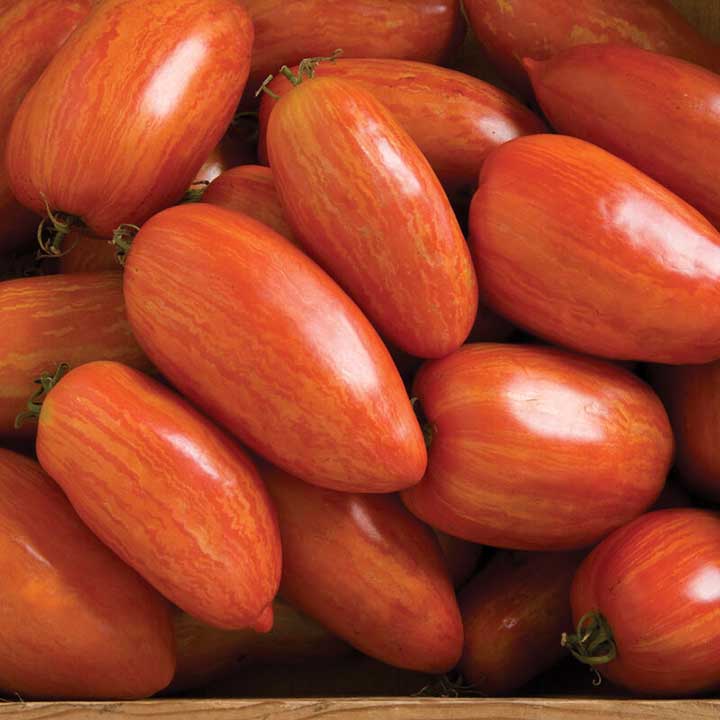
Type: heirloom paste
If you’re looking for a canning tomato that is a bit different from the traditional red plum tomato, check out Speckled Roman. The fruits have an elongated plum shape and red skin with yellow stripes.
The tomatoes have a meaty interior with great flavor and few seeds. That means these fruits are great for canning, but they can also be used for fresh eating.
I’ve grown Speckled Roman in the past and find the flavor is much better than other plum-type tomatoes. Their unique appearance also makes them stand out from the crowd.
Pros
- Delicious flavor
- Great texture for canning
Cons
- Not the best disease resistance
7. GinFiz
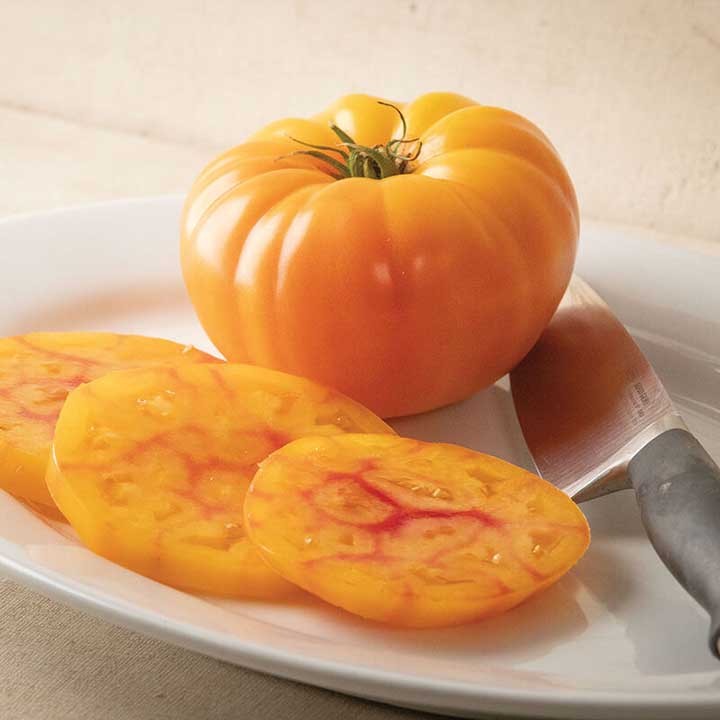
Type: hybrid slicer
Many people love the appearance and taste of heirloom tomatoes but wish the plants had better disease resistance. Enter “hylooms” like GinFiz.
This tomato looks and tastes like heirlooms such as Striped German, but it is technically a hybrid. Plant breeders have bred in resistance to common tomato diseases as well as resistance to cracking.
GinFiz is designed to grow in a protected culture system like a high tunnel or greenhouse, but you can always try your hand at growing it outdoors.
Pros
- Strong disease resistance
- Higher production than many similar heirlooms
Cons
- Seeds are expensive
- Designed for protected culture
8. Darkstar
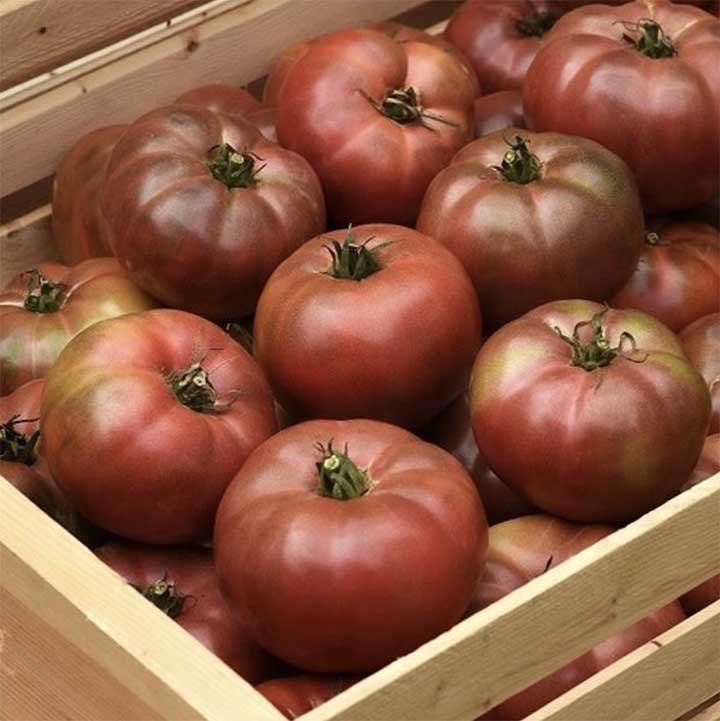
Type: hybrid slicer
Darkstar is another “hyloom” tomato that has the characteristics of an heirloom with the resistance of a hybrid.
This variety has dark purple fruits that resemble favorites like Cherokee Purple and Black Krim. The tomatoes are medium-sized, making them suitable for sandwich slices and salads.
Along with producing great-tasting fruit, Darkstar also comes with high resistance to late blight and more prolific fruit production compared to heirloom varieties.
Pros
- High yielding
- Delicious fruits
- Resistant to late blight
Cons
- Flavor is a bit less than similar heirlooms
9. Aunt Ruby’s German Green
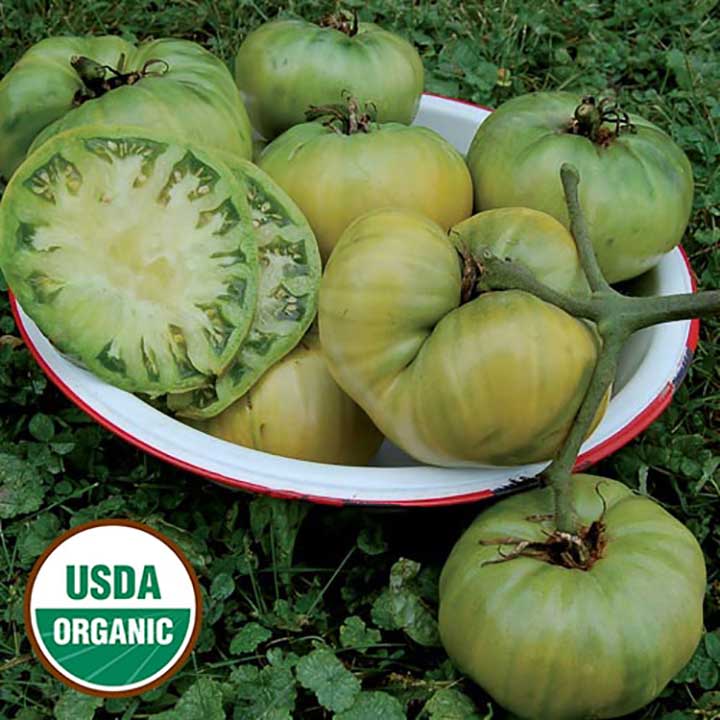
Type: heirloom slicer
A ripe green tomato? That’s right!
Aunt Ruby’s German Green produces fruits that remain green when ripe. Although the color does change slightly as the fruits ripen, it can take some practice to differentiate the ripe fruits from unripe ones.
The fruits are large and can often weigh over a pound each. The flavor is mostly sweet with enough acidity to make the fruits well-balanced.
These tomatoes do take a while to mature (about 90 days), so it’s best to get them planted out in the garden as soon as the danger of frost has passed.
Pros
- Great tasting fruits
- Unique
Cons
- Can be difficult to know when to harvest
- Fruits can be very large
10. Paul Robeson

Type: heirloom slicer
When this Russian heirloom first burst into the gardening scene in the United States, many claimed it has the best flavor of any tomato. Whether that is true depends on personal preferences, but this tomato still remains a popular purple option.
The fruits are medium in size and deep purplish-red. The interiors are both meaty and juicy, which makes them a versatile option in the kitchen.
Pros
- Great tasting
- Nicely sized fruits
Cons
- Lacking disease resistance
If you want to give this tomato variety a try, read to know how I grow Paul Robeson tomatoes.
11. Sunpeach
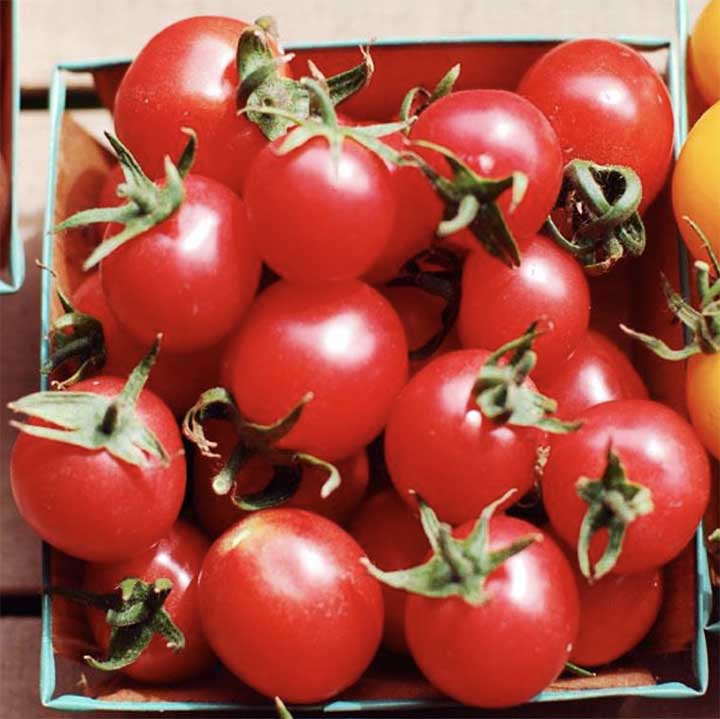
Type: hybrid cherry
In the past few years, Sunpeach has become one of my favorite cherry tomatoes to grow. It produces loads of bright pink cherry tomatoes that have great flavor and also resist cracking.
The plants themselves also hold up well to some common plant diseases, especially if you take the time to prune the plants in order to improve airflow.
I like to plant Sunpeach with other varieties of cherry tomatoes to create beautiful colored mixes.
Pros
- Great tasting
- Resistant to cracking
Cons
- Susceptible to early and late blight
12. Sakura

Type: hybrid cherry
If you’re looking for a new variety of red cherry tomato to try out, I recommend Sakura. These plants produce hundreds of delicious fruits, and they are also some of the first cherry tomatoes to ripen each year.
The plants have good resistance to Fusarium wilt, leaf mold, and tomato mosaic virus. If you grow them in a structure that protects them from the elements, Sakura can keep producing fruits for months on end.
Pros
- Early producer
- Prolific
Cons
- Susceptible to early and late blight
13. German Johnson

Type: heirloom slicer
Looking for a big tomato? Then check out German Johnson!
This heirloom variety produces huge pink fruits with a rich and balanced flavor. Compared to similar varieties like Brandywine, it is more prolific and produces more fruit.
I’ve found some of the tomatoes crack along the stem before they are ready to harvest. If this is the case, you can still eat the tomatoes, just be aware these open spots may begin to rot within a few days.
Pros
- Delicious fruits
- More prolific than similar varieties
Cons
- Fruits prone to cracking
14. Juliet
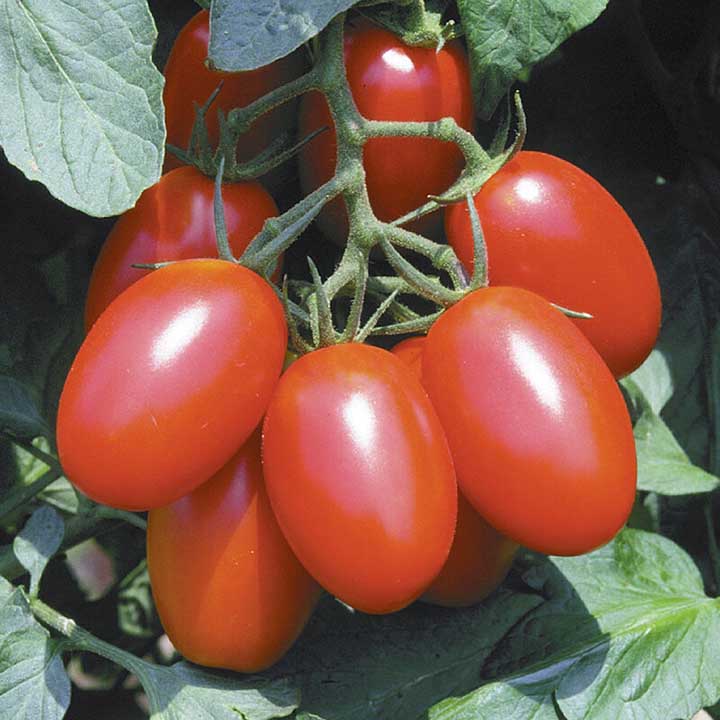
Type: hybrid grape
Juliet is a hybrid variety that produces grape-shaped tomatoes that are perfect for salads, salsa, sauce, and roasting. They have a deep tomato flavor that will have all the lovers of classic red tomatoes rejoicing.
The plants are prolific and also have good resistance to early blight, late blight, and cracking. Once picked, the fruits keep well for a while off of the plant.
Pros
- Prolific
- Crack resistant
- Resistant to blight
- Good shelf life
Cons
- Susceptible to wilts and leaf mold
15. Supersweet 100

Type: hybrid cherry
Perhaps the most classic red cherry tomato, Supersweet 100 has made its way into thousands of gardens over the years. The plant produces large clusters of tiny red fruits that pop in the mouth and have eaters coming back for more.
This variety is a hybrid and holds resistance to Fusarium wilt and Verticillium wilt.
Pros
- High yielding
- Sweet fruits
- Resistance to wilts
Cons
- Susceptible to blights
16. Black Cherry

Type: heirloom cherry
Another beautiful cherry tomato is the Black Cherry. As its name suggests, it produces small dark purplish-red fruits that can appear almost black.
The plants are known for producing loads of fruit that have a rich and robust flavor. Try planting them with other varieties of cherry tomatoes for a colorful and interesting mix.
Pros
- Delicious taste
- Prolific
Cons
- Poor disease resistance
17. Striped German
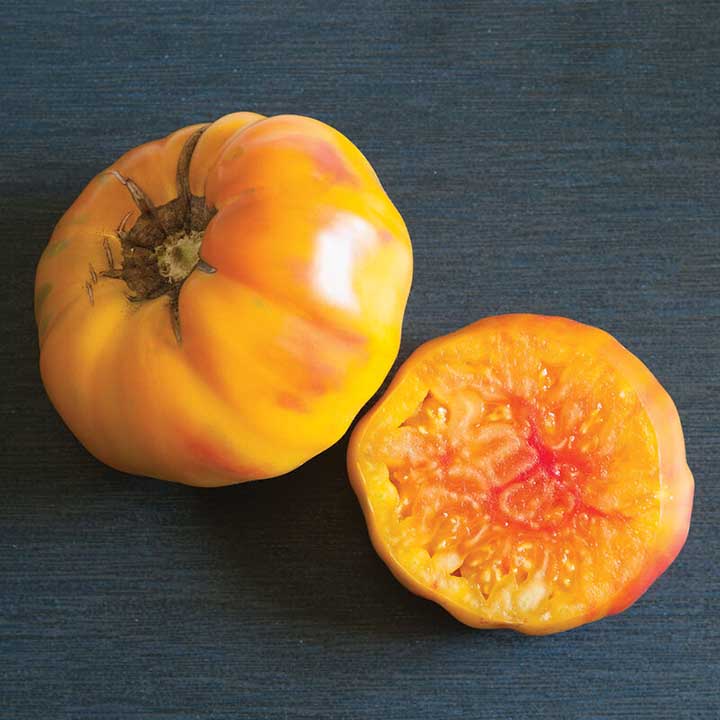
Type: heirloom slicer
If you like sweet tomatoes without much acidity, you should stick to yellow varieties. The Striped German is one of the most popular yellow heirlooms out there, and for good reason.
The plants produce large yellow-slicing tomatoes that have red streaks on their bottoms. When you slice into the fruits, you’ll be met with stunning bi-color flesh.
Pros
- Sweet fruits
- Unique
- Large tomatoes
Cons
- Poor disease resistance
- Fruits prone to cracking
18. Purple Bumble Bee
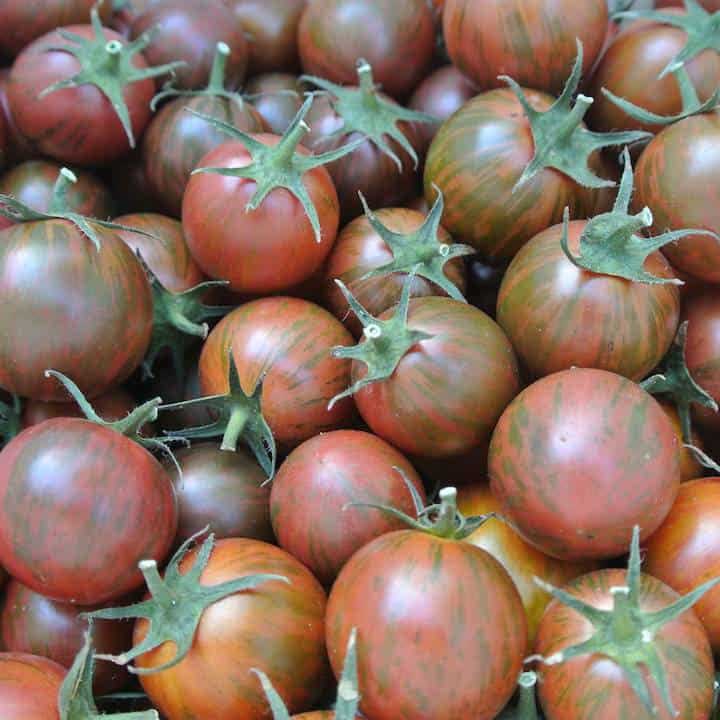
Type: hybrid cherry
The Purple Bumble Bee is just one indeterminate tomato in the Bumble Bee line. It is a cherry tomato with dark red skin covered in green streaks.
There are also Sunrise (yellow and pink) and Pink (pink and yellow) Bumble Bee tomatoes that work well mixed with the Purple Bumble Bee.
All of these varieties produce lots of fruit, even under relatively harsh conditions. However, the fruits do have a bit of a thicker skin than other cherry tomato varieties.
Pros
- Prolific plants
- Beautiful fruits
- Great disease resistance
Cons
- Tougher skin
- Taste is just okay
19. Sunorange
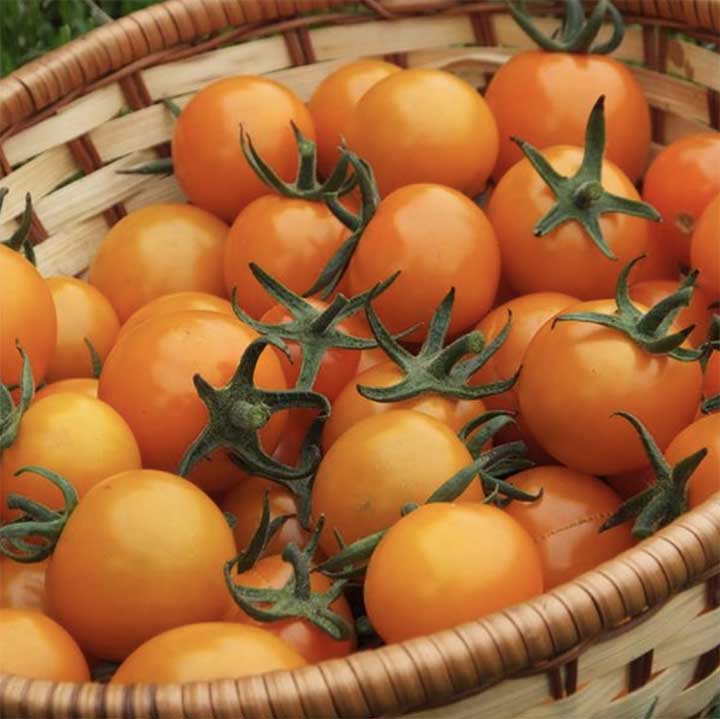
Type: hybrid cherry
If you love the flavor of Sungolds but don’t like how they tend to crack on the vine, check out Sunorange. The plants produce even more tomatoes than Sungold, and the fruits are crack resistant.
The flavor is just as sweet and delicious as Sungold, and I’ve been happy with switching from Sungold to Sunorange.
Pros
- Sweet fruits
- Prolific fruit production
- Fruits crack resistant
Cons
- Seeds are more expensive
20. Arkansas Traveler
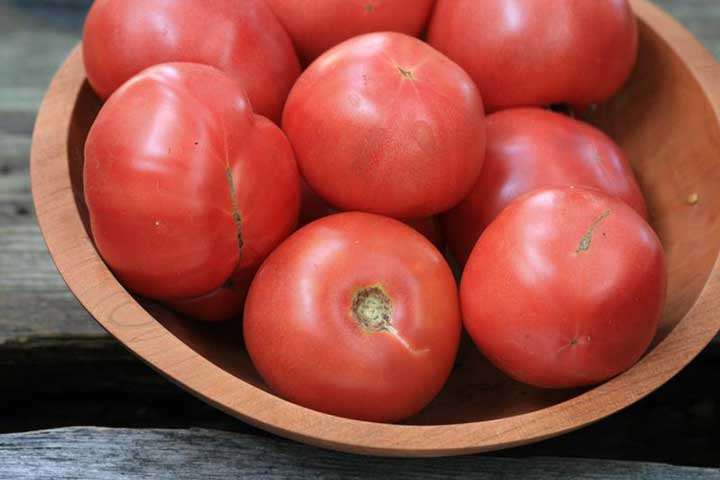
Type: heirloom slicer
This heirloom variety is one of the longest-lived favorites when it comes to slicing tomatoes. It originated in the Ozark Mountains in Arkansas sometime in the late 1800s, where it quickly became a hit.
The plants produce medium-sized dark pink tomatoes that are good for both sauce and slicing. Along with their good flavor, the plants are also loved for their ability to produce fruits even in hot and dry conditions.
Pros
- Good flavor and texture
- Withstands heat and drought
Cons
- Susceptible to disease
21. San Marzano

Made famous by Italians, the San Marzano is a great option if you’re looking for a paste tomato. The plum-shaped fruits are meaty and rich, which decreases the time you need to boil sauce before canning.
The fruits are a bit larger than many Roma-type tomatoes, making them easy to pick. I’ve also found the fruits resist cracking, even after heavy rains and inconsistent watering.
Some varieties of San Marzano are semi-determinate in form, which means they remain shorter. However, most types are indeterminate and can grow quite tall
Pros
- Great tasting fruits
- Superb for sauce and canning
Cons
- Susceptible to disease
My Tips for Growing Indeterminate Tomatoes
To keep your indeterminate tomatoes happy and healthy, follow these tips.
Contain the Plants
When it comes to growing indeterminate tomatoes, you need to have a containment strategy in place. These plants’ vines can easily reach over ten feet long and can exceed 30 feet if they receive the proper care.
If you are growing your tomatoes outdoors in the garden, you have multiple options for trellising. While you can use a classic metal tomato cage, indeterminate tomatoes will quickly outgrow the cage.
Another method is to use stakes and tomato twine. Put two stakes on either side of the plant, about a foot away from the plant’s stem.
Wrap a piece of tomato twine around one side of the tomato stem and then the other, ensuring the twine is pulled tight. Continue to add more pieces of twine as the tomato grows.
Eventually, the plants will outgrow the top of the stakes. At this point, you have a few options.
You can trim the tops of the plants and allow the suckers to continue to grow. Or you can allow the plants to keep growing, and simply let them flop over the top pieces of twine.
Continue to Fertilize
Since these plants continue to grow and produce fruit over multiple months, they can benefit from continual fertilization.
I like to use a liquid fertilizer specifically designed for tomato plants and apply it every two weeks. If you are on a small scale, you can use a watering can to apply the fertilizer to the soil at the base of the plant.
Harvest at Least Twice a Week
Once indeterminate tomato plants begin producing fruits, they need to be harvested on a regular basis. I maintain a twice-a-week harvest schedule for all my tomatoes.
If you skip a harvest date, you may come back to rotten, overripe, or cracked fruit. Keeping with a regular harvest schedule makes harvesting easier and more enjoyable.
